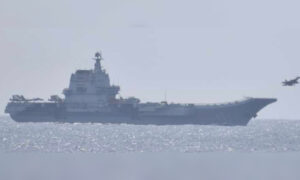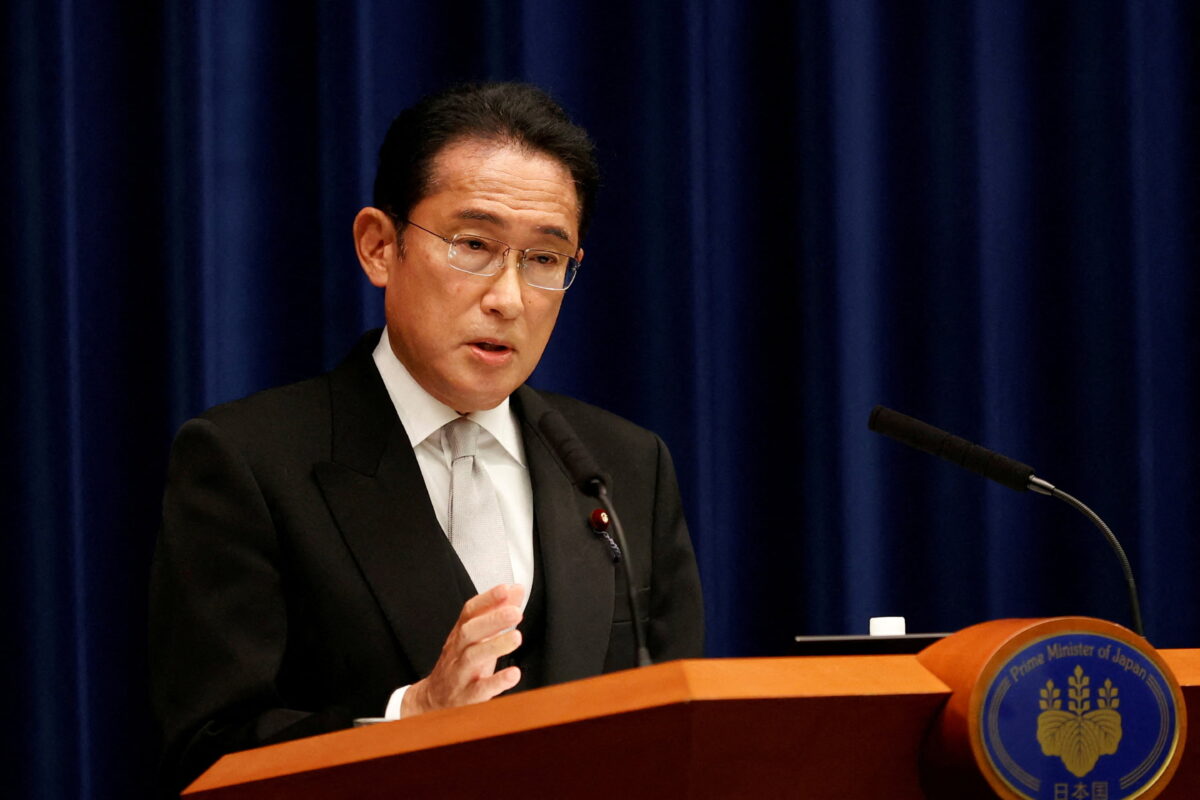Chinese Warships Circle Japan Amid Missile Defense System Deployment
Chinese People’s Liberation Army (PLA) ships were spotted circling Japan for days in an apparent show of force amid Japan’s missile defense system deployment on an island near Taiwan. Japan’s defense ministry said on May 11 that a Chinese naval flotilla, led by the PLA’s Type 055 guided missile destroyer Lhasa, has been spotted sailing around Japan-controlled islands since April 30. The flotilla was first spotted traversing Japan’s Tsushima Strait on April 30. The ministry stated that the Chinese warships sailed through the Tsugaru Strait from May 5 to 6 and then in the Izu island chain, which sits south of Tokyo, on May 11. This came as Japan deployed the PAC-3 surface-to-air missile defense system on Miyako Island, which is situated close to Taiwan, the self-ruled island that China claims as its territory and has vowed to seize by any means necessary. Japan also stationed PAC-3 missiles at the Ishigaki and Yonaguni islands, Chief Cabinet Secretary Hirokazu Matsuno told reporters on May 8. The government has said the deployment was meant to deter North Korea’s missile threat. “We’ll make coordination with local governments and deploy the system in locations where it is needed,” a defense ministry official said on April 24, Jiji Press reported. “We’ll be thoroughly prepared.” However, China’s state-owned Global Times criticized Japan’s move as “provocative,” claiming that it was not aimed at countering threats from the Korean Peninsula but rather meant to “prepare for military intervention in the Taiwan question.” In another report, the news outlet said that China’s recent deployment of a flotilla could send “a strong message” to Japan in response to what it described as “Japan’s provocative remarks” about Taiwan. The report also accused Japan of “hyping the China threats.” Ahead of G-7 Summit The incident occurred ahead of the G-7 Summit in Hiroshima, Japan, on May 19, which will be attended by heads of the leading industrial states in the group, including U.S. President Joe Biden and Canadian Prime Minister Justin Trudeau. Japanese Prime Minister Fumio Kishida speaks during a news conference at the prime minister’s official residence in Tokyo on Aug. 10, 2022. (Rodrigo Reyes Marin/Pool via Reuters) Japanese Prime Minister Fumio Kishida said on May 15 that G-7 leaders want to reaffirm that any “unilateral attempts by China and Russia to change the status quo by force” won’t be accepted, Kyodo News reported. Kishida’s remarks echoed the G-7 foreign ministers’ call on April 16 for a “peaceful resolution of cross-Strait issues” between China and Taiwan. The ministers said the unity of G-7 nations is “extremely important” in dealing with the various challenges facing the Indo-Pacific region, including the threats posed by communist China and North Korea, according to Japan’s foreign ministry. Japanese Foreign Minister Yoshimasa Hayashi emphasized the need to “continue dialogue with China” while also “directly expressing” concerns and urging China to “act as a responsible member of the international community.” During a bilateral meeting in Beijing on April 2, Hayashi raised concerns over “China’s intensification of military activities around Japan”—particularly near the Japanese-controlled Senkaku Islands that China also claims are its own—and China’s cooperation with Russia. In response, Chinese Foreign Minister Qin Gang warned Japan to refrain from “interfering in the Taiwan issue or undermining China’s sovereignty in any form.” He said the Taiwan issue is “at the very core of China’s core interests.” Qin said that Beijing is willing to work with Tokyo to “properly manage differences, remove obstacles, and ease burdens for bilateral relations, and build a China–Japan relationship that meets the requirements of the new era.”

Chinese People’s Liberation Army (PLA) ships were spotted circling Japan for days in an apparent show of force amid Japan’s missile defense system deployment on an island near Taiwan.
Japan’s defense ministry said on May 11 that a Chinese naval flotilla, led by the PLA’s Type 055 guided missile destroyer Lhasa, has been spotted sailing around Japan-controlled islands since April 30.
The flotilla was first spotted traversing Japan’s Tsushima Strait on April 30. The ministry stated that the Chinese warships sailed through the Tsugaru Strait from May 5 to 6 and then in the Izu island chain, which sits south of Tokyo, on May 11.
This came as Japan deployed the PAC-3 surface-to-air missile defense system on Miyako Island, which is situated close to Taiwan, the self-ruled island that China claims as its territory and has vowed to seize by any means necessary.
Japan also stationed PAC-3 missiles at the Ishigaki and Yonaguni islands, Chief Cabinet Secretary Hirokazu Matsuno told reporters on May 8. The government has said the deployment was meant to deter North Korea’s missile threat.
“We’ll make coordination with local governments and deploy the system in locations where it is needed,” a defense ministry official said on April 24, Jiji Press reported. “We’ll be thoroughly prepared.”
However, China’s state-owned Global Times criticized Japan’s move as “provocative,” claiming that it was not aimed at countering threats from the Korean Peninsula but rather meant to “prepare for military intervention in the Taiwan question.”
In another report, the news outlet said that China’s recent deployment of a flotilla could send “a strong message” to Japan in response to what it described as “Japan’s provocative remarks” about Taiwan.
The report also accused Japan of “hyping the China threats.”
Ahead of G-7 Summit
The incident occurred ahead of the G-7 Summit in Hiroshima, Japan, on May 19, which will be attended by heads of the leading industrial states in the group, including U.S. President Joe Biden and Canadian Prime Minister Justin Trudeau.

Japanese Prime Minister Fumio Kishida said on May 15 that G-7 leaders want to reaffirm that any “unilateral attempts by China and Russia to change the status quo by force” won’t be accepted, Kyodo News reported.
Kishida’s remarks echoed the G-7 foreign ministers’ call on April 16 for a “peaceful resolution of cross-Strait issues” between China and Taiwan.
The ministers said the unity of G-7 nations is “extremely important” in dealing with the various challenges facing the Indo-Pacific region, including the threats posed by communist China and North Korea, according to Japan’s foreign ministry.
Japanese Foreign Minister Yoshimasa Hayashi emphasized the need to “continue dialogue with China” while also “directly expressing” concerns and urging China to “act as a responsible member of the international community.”
During a bilateral meeting in Beijing on April 2, Hayashi raised concerns over “China’s intensification of military activities around Japan”—particularly near the Japanese-controlled Senkaku Islands that China also claims are its own—and China’s cooperation with Russia.
In response, Chinese Foreign Minister Qin Gang warned Japan to refrain from “interfering in the Taiwan issue or undermining China’s sovereignty in any form.”
He said the Taiwan issue is “at the very core of China’s core interests.”
Qin said that Beijing is willing to work with Tokyo to “properly manage differences, remove obstacles, and ease burdens for bilateral relations, and build a China–Japan relationship that meets the requirements of the new era.”












